- Inception till Date
- The Founder and Other Heads
- Description of the Monastery
- The Maitreya Statue
Ghoom Monastery is the popular name of the Yiga Choeling Monastery located at Ghoom at an elevation of 8,000 feet, 8 km from Darjeeling in the state of West Bengal.

The monastery belongs to the Gelukpa or the Yellow Hat sect and is famous for its 15 feet high special statue of the Maitreya Buddha. The external structure of the building was established in 1850 by the famous Mongolian astrologer and monk Sokpo Sherab Gyatso. Since 1850 to 1905 he had administered as the head of the monastery. Later he went to Tibet and died in his birth province.
In 1909 Kyabje Domo Geshe Rinpoche Ngawang Kalsang, popularly called Lama Domo Geshe Rinpoche, succeeded Sherab Gyatso as head of the monastery. The main statue inside the temple is that of the Maitreya Buddha (Gyalwa Shampa) or the Future Buddha. This 15 feet high statue was specially commissioned during his tenure. He acted as the head of the monastery since 1910 to 1952. Later, he went to Tibet and died in his birth place.
During the Chinese occupation of 1959 in Tibet many high ranking abbots fled to India and took refuge in this monastery. In 1951 H.H. the Dalai Lama sent H.E the Dhardo Rinpoche as a head monk of Tibetan monastery in Bodh Gaya. In 1961 he was sent as a head of the Yiga Choeling monastery Ghoom, Darjeeling.

He passed away in 1990 and three years after his demise, a boy named Tenzin Legshad Wangdi was recognized as his reincarnation.
On 25th April 1996 he was enthroned at Kalimpong Tibetan ITBCI school with monastic custom. The thirteenth in the line of Tulkus, Tenzin Legshad Wangdi, still goes by the name of Dhardo Tulku. At present H.E. Tenzin Legshad Wangdi is studying Tibetan Philosophy in Drepung Loseling University in South India. Under the supervision of H.E the Dhardo Rinpoche, the Managing Committee was set up in order to uplift the monastery. Since then various policies have been formulated and implemented and some became successes and others went in vain due to certain circumstances.
For the last two decades the monastery has been going through severe crises in terms of both monks and finance. Till now, the grants-in-aid entitled to the monastery have not been received either from government nor from any other source. Presently the monastery is meeting its needs through donations and contributions from local devotees.
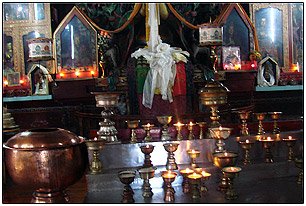

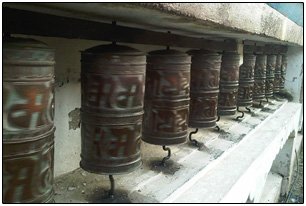
Sherab Gyatso
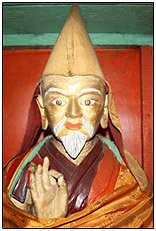
Sherab Gyatso was one of the most famous of the Mongolian scholars and astrologer in Tibet and India in the 19th century and had also been a tutor to the Eighth Panchen Lama. He founded the Ghoom Yiga Choeling Monastery in mid-nineteenth century. Ghoom Monastery is the first ever Tibetan Buddhist monastery built in the Darjeeling region (what is now Darjeeling District of West Bengal state of India). He is believed to have authored several books on Tibetan astrology, but they were lost from the library of Ghoom Monastery during later years
Domo Geshe (1866 - 1936)
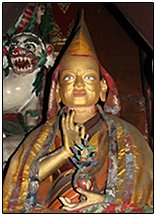
Kyabje Domo Geshe Rinpoche Ngawang Kalsang, popularly called Lama Domo Geshe Rinpoche, succeeded Sherab Gyatso as head of the monastery. Much of the biographical material on the former Domo Geshe Rinpoche was destroyed together with Dungkar Gonpa Monastery in Tibet during the Cultural Revolution.
However, some information about this legendary figure, whose previous incarnations are said to include Shariputra, the Mahasiddha Gayadhara, Dharmashri, Munijnana, Thönmi Sambhota, King Trisong Detsen, Dromtönpa, Milarepa, Khedrup Rinpoche, and Tragpa Gyaltse can be found in different sources, including some biographical material by a Western disciple, Lama Govinda, in his book The Way of the White Clouds.
In the Indian Himalayan region he was also known as "the precious doctor of Chumbi", since he healed so many people with a variety of methods. The famous holy pills (rilbus) he made from hundreds of holy and medicinal ingredients were of unequaled power and healed many otherwise hopeless cases. No photograph exists of him. When pictures were taken without his permission, he is either not there or blurred beyond recognition. The only likeness that exists of Domo Geshe Rinpoche is a statue fashioned after the preserved body that was placed in his stupa.
The main 15 feet high statue of the Maitreya Buddha was specially commissioned during his tenure. He acted as the head of the monastery since 1910 to 1952. Later, he went to Tibet and died in his birth place.
Dhardo Rinpoche (1917-1990)
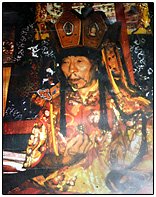
Dhardo Rinpoche was the 13th in a line of tulkus from Dhartsendo on the eastern border of Tibet. Dhardo Rinpoche was educated in the traditional Tibetan monastic style, taking his Geshe Degree and graduating at the Lharmapa level at Drepung Monastery, and doing further study at Gyud-med Tantric College. In 1951 he was appointed abbot of the Tibetan monastery at Bodh Gaya, and then in 1954 moved to Kalimpong near the India-Tibet border. Kalimpong was to become an important staging post for Tibetans fleeing the Chinese invasion. He founded the Indo-Tibetan Buddhist Cultural Institute (ITBCI) in 1952 which then opened an orphanage and school for Tibetan refugees in Kalimpong, which is now one of the reputed Tibetan Schools in the Darjeeling district.
Dhardo Rinpoche He was the abbot of YigaChoeling Monastery, Ghoom from 1964 till his death in 1990. Dhardo Rinpoche's motto was: "Cherish the doctrine; live united; radiate love". He was concerned especially to teach the children at his school that "actions have consequences".
Tenzin Legshad Wangdi (born 1991)
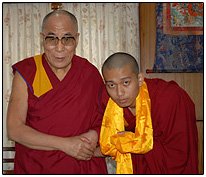
The 14th in the line of Tulkus, Tenzin Legshad Wangdi, was born in 1991 and was recognized to be the reincarnation of H.E. The Dhardo Rinpoche by the 99th Ganden Tripa – the representative of Tsongkhapa (the Founder of the Gelugpa school). He was also recognized or confirmed to be the reincarnation of H.E. Dhardo Tulku by H.H. The 14th Dalai Lama in September 1995. He still goes by the name of Dhardo Tulku.
At present H.E. Tenzin Legshad Wangdi is studying Tibetan Philosophy in Drepung Loseling University in South India.
Description of the Interiors of the Monastery
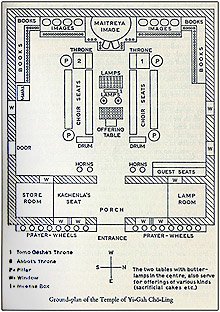
In the center of the shrine hall is the main statue of theLord Maitreya Buddha which is 15 feet in height. It is the biggest and the oldest statue among all the monasteries in Darjeeling. The statue is made up entirely of clay brought from Tibet. On the right side of the main statue are the three statues of Buddha which symbolizes the past, present and future Buddha. On top of them are images of the 14th Dalai Lama, Tsongkhapa and two main attendants of Buddha, Sherigbhu and Mongalbhu and the founder of the monastery Lama Sherab Gyatso and the 9th reincarnated Penchen Lama.
On the left side are images of Domo Geshe Rinpoche who constructed the main statue of Maitriya Buddha and next to him the idol of Chenrezig-Avalokiteswara "the god with 1000 hands, 1000 eyes and 11 heads, the god of love and compassion". It is believed that H.H. The Dalai Lama is the reincarnation of Avalokiteswara.
On the top right of Chenrezig is the idol of Lord Manjushree. Placed below it is Lord Amitabha Buddha and on the top left is the idol of Vajrapani or Shakna Dorje thewrathful protector diety. Just below Shakna Dorje is the idol of Guru Padmasambhava or Guru Rinpoche who was one of the greatest saints of Buddhism who is responsible for the spread of Buddhism in Tibet.

On either side of the main altar are the huge book shelves where the holy books of Buddhism are kept. The Kangyur and Tengyur consisting of 102 and 213 volumes the commentary and philosophy of Tibetan Buddhism, deserve special mention in this collection at the library.
The monastery holds two special seats of H.H. The Dalai Lama and the head of incarnated Lama. In front of the Maitreya Buddha image are two huge oil lamps which keep on burning throughout the year. The entire monastery's walls portray the magnificent paintings and arts of Tibetan Buddhism with different images of bodhisattvas. These beautiful paintings are placed in a symmetrical manner, making it very easy for any visitor to understand the basics of Buddhist philosophy.
At the hilltop above the monastery, is situated the Ma Kali temple. Devotees come to offer prayer on every full moon day and on the fifteenth of every month of the Tibetan calendar.
Maitreya Statue at Yiga Choeling Monastery

Domo Geshe Rinpoche enlarged the Yiga Chöling Monastery at Ghoom and built a famous two-story Maitreya Buddha statue with the help of the artist Wangyal from Lhasa. By building this statue he fulfilled two prophecies at once. Not only had his Guru Rangjung Lama Lobsang Zöpa predicted this event, but the exalted master Dromtönpa, the main disciple of glorious Atisha Dipamkara, had foretold it hundreds of years earlier.
Upon request, the best artist, Ü Döndrup Wangyal, had been sent from Lhasa. The statue was fashioned of clay mixed with many ground-up precious stones and holy things, it is about two stories high. When it was consecrated, gods and goddesses showered down flowers.
Between the eyes of the statue a huge diamond reflected the light of the many butterlamps. Humans and non-humans had offered the precious materials for it. When the Maitreya statue was consecrated, gods and goddesses showered down flowers from Tushita, and many people, even as far away as Darjeeling, said they heard very beautiful music.
Lord Maitreya
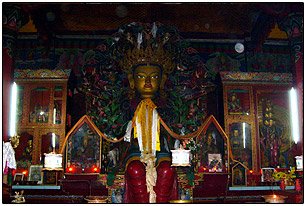
Maitreya (Sanskrit), Metteyya (Pāli), or Jampa (Tibetan), is a future Buddha of this world in Buddhist eschatology.
Maitreya is a bodhisattva who in the Buddhist tradition is to appear on Earth, achieve complete enlightenment, and teach the pure dharma. According to scriptures, Maitreya will be a successor of the historic Śākyamuni Buddha. The prophecy of the arrival of Maitreya references a time when Dharma will be forgotten on Jambudvipa. It is found in the canonical literature of all Buddhist sects (Theravāda, Mahāyāna, Vajrayāna), and is accepted by most Buddhists as a statement about an event that will take place when Dharma will be forgotten on Earth.
Maitreya is typically pictured seated, with either both feet on the ground or crossed at the ankles, on a throne, waiting for his time. He is dressed in the clothes of either a Bhiksu or Indian royalty. As a bodhisattva, he would usually be standing and dressed in jewels. Usually he wears a small stupa in his headdress that represents the stupa of the Buddha Sakyamuni's relics to help him identify it when his turn comes to lay claim to his succession, and can be holding a dharmachakra resting on a lotus. A khata is always tied around his waist as a girdle.



